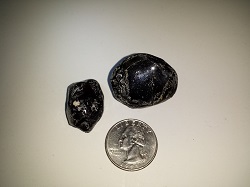APACHE TEARS:
"Apache tears" is the popular term for rounded pebbles of obsidian or "obsidianites" composed of black or dark-colored natural volcanic
glass, usually of rhyolite composition and bearing conchoidal fracture. Also known by the lithologic term "marekanite", this variety of
obsidian occurs as subrounded to subangular bodies up to about 2 inches in diameter, often bearing indented surfaces.[1] Internally the
pebbles sometimes contain fine bands or microlites and though in reflected light they appear black and opaque, they may be translucent
in transmitted light. Apache tears fall between 5 and 5.5 in hardness on the Mohs scale.Apache tears originate from siliceous lava
flows, lava domes or ash-flow tuffs, often in close association with or embedded in, gray perlite. The spherules occur as cores within
perlite masses that typically exhibit texture of concentrically curved, onion-skin fractures. Formation is apparently related to
differential cooling and various alkali and water contents. Excessive water present during cooling and quenching of rhyolitic lava
causes obsidian to hydrate (i.e., water entering the obsidian glass converts it to perlite). Where perlite is incompletely hydrated,
fresh obsidian cores
remain as pebbles of marekanite or Apache tears.

CLICK ON IMAGE TO SEE LARGER PICTURE
|

